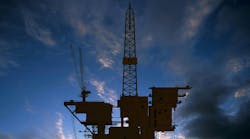Nick Snow
Washington Correspondent
WASHINGTON, DC, Mar. 15 -- Government policymakers seeking to determine where new LNG terminals are to be located and how existing facilities and tankers can be protected need additional studies conducted examining potential problems resulting from large LNG spills, said the Government Accountability Office in a new report.
Although past studies have developed modeling assumptions based on small-scale spill data, there have been no large-scale LNG spills or spill experiments, GAO reported. "While there is general agreement on the types of effects from an LNG spill, the results of these models have created what appears to be conflicting assessments of the specific consequences of an LNG spill, creating uncertainties for regulators and the public," the report said.
It said the US Dept. of Energy has funded a study to address large-scale LNG fires, but added that it will address only 3 of the 10 top issues that a panel of GAO-assembled experts identified as potentially affecting public safety. The planned DOE study currently does not plan to address cascading failure of LNG tanks, which its experts ranked second most important after large fire phenomena, GAO said.
For its year-long analysis, the congressional watchdog service assembled 19 LNG experts to discuss potential consequences of a terrorist attack on an LNG tanker. It described the results of 6 unclassified studies of the consequences of an LNG spill that contained new, original research (either experimental or modeling) and clearly described the methodology used. It also interviewed US agencies responsible for LNG regulations and visited all four US onshore LNG import terminals and one export facility.
GAO said the 19 experts agreed that the most likely public safety impact from an LNG spill would be heat from a fire, that explosions are not likely to occur in the wake of a spill unless LNG vapors are in confined spaces, and that some hazards, such as freeze burns and asphyxiation, do not threaten the public.
The experts disagreed with heat impact and cascading tank failure conclusions in a Sandia National Laboratories study the US Coast Guard uses to prepare waterway suitability assessments for applications to construct LNG terminals. Specifically, several of the experts disagreed with the 1,600-m heat impact distance estimate in the Sandia study, and the conclusion that only three of five tanks on an LNG vessel would be involved in a cascading failure.
Urges broader study
To provide the most comprehensive information for assessing public safety risks of LNG tankers traveling to proposed facilities, GAO recommended that the US Energy Secretary ensure that the 10 key issues identified by GAO's panel of experts be incorporated into DOE's study, particularly the potential for cascading failure of LNG tanks, in order to better understand potential damage to the vessel's hull from extreme cold or heat. DOE officials have agreed with the recommendation, GAO said.
The leadership and members of the House Energy and Commerce Committee who requested the GAO report said its release on Mar. 14 coincides with a projected 400% increase in LNG imports over the next 10 years at a time when energy companies have submitted 32 applications to build new terminals in 10 states and at 5 offshore sites. The terminals are regulated onshore by the Federal Energy Regulatory Commission and offshore by the Coast Guard.
Chairman John D. Dingell (D-Mich.) and Ranking Minority Member Joe Barton (R-Tex.) said that the committee would hold hearings on LNG tanker and terminal security and licensing. "In a post 9/11 era, we need answers about the safest way to handle LNG in light of the fact that it is slated to fill 17% of US gas requirements over the next decade," Dingell said. He indicated that in the hearings the committee would review the planned DOE study to ensure that it is conducting the necessary research to make sound siting decisions and to examine the positive and negative aspects of locating terminals onshore and offshore.
Barton cited the strong safety record of LNG shipments, noting that more than 40,000 tankers have delivered the fuel over 47 years without a major spill. "In the unlikely event of an LNG tanker fire, most experts surveyed by GAO agree that the protection zones already required for LNG tankers will do the job of protecting the public. That's good news, but given the long history of safety, it's also what we expected. GAO's recommendation for further research is only prudent, however, and I'm confident that FERC will continue to apply the latest science to support its licensing decisions," he said.
Edward J. Markey (D-Mass.), a committee member whose district includes the nation's only urban import terminal for LNG, said that GAO's findings show that further studies clearly are needed, and that DOE needs to expand its current examination immediately to examine all the safety issues GAO's assembled experts identified.
Bart Stupak (D-Mich.), who chairs the committee's Oversight and Investigations Subcommittee, said it plans to examine national security implications of the energy supply system because it is concerned about how the government can best assure that LNG is delivered safely and efficiently, given increasing US reliance on it.
Contact Nick Snow at [email protected].

